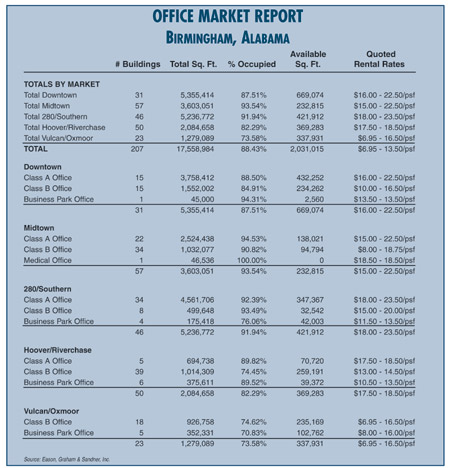|
SOUTHEAST SNAPSHOT, OCTOBER 2004
Birmingham Office Market
 |
|
Barbara Bushnell
Associate Broker
Eason Graham & Sandner
|
|
The current trend in the Birmingham, Alabama, office market
is small- to mid-size space users who desire to own their
office facility. A shortage of buildings in the 5,000- to
10,000-square-foot range, coupled with an interest in multi-use
live/work environments, is spurring rehabilitation projects
throughout the city of Birmingham. Older structures in the
central business district are candidates for office and loft
redevelopment, while new construction in the suburban markets
is combining office, retail and residential uses.
“Large-scale office development is presently arrested
as a result of several years of market softness and sluggishness
in the rate of absorption,” says Barbara Bushnell, associate
broker with Eason Graham & Sandner. “The past year
has seen a significant reduction in the amount of sublease
space available and moderate tightening of overall availability.”
As a result, no new large, multi-tenant office buildings are
slated for construction until 40 to 50 percent of pre-leasing
commitments are secured.
A significant development that is sure to impact the market
includes two buildings built in the late 1980s to house BellSouth
Corporation. Located in Colonnade at the highly desirable
intersection of U.S. 280 and Interstate 459, the buildings
are being vacated as employees are relocated to other facilities
in the Birmingham area. The larger of the two buildings, totaling
430,000 square feet with 45,000-square-foot floor plans, will
be available first. The smaller 265,000-square-foot building
will be made available as demand warrants.
“This is a tremendous opportunity for Birmingham to attract
large regional space users,” says Bushnell. “Economic
development efforts in our market have historically been hampered
by the lack of large blocks of space which will now be available
at the Colonnade.”
The recent merger of SouthTrust Bank with Wachovia also will
have a great effect on the office market. The merger will
mean a significant loss of jobs in the Birmingham market accompanying
the loss of a major bank headquartered in the CBD. At the
same time the SouthTrust presence is waning, the recent merger
of Regions Bank and Union Planters is a positive development
drawing new bank officials to Birmingham.
The majority of growth in the market is occurring along the
U.S. 280 corridor — south and east of the CBD —
and along the I-459 beltway. “Growth is being driven
by proximity to new suburban housing developments, increased
traffic congestion along major arteries into the city and
occupational tax issues within the municipal limits of the
city of Birmingham,” says Bushnell.
Another growth corridor gaining momentum and worth monitoring
in the future is the Interstate 20 area between Birmingham
and Atlanta, being fueled by the location of the Honda plant.
New housing, warehouse and retail construction is underway,
with medium-sized office facilities likely to follow suit.
Though presently there is not an influx of new office developers
in the Birmingham market, the CBD has attracted some small
developers from larger markets involved in the retrofitting
older office and warehouse structures for loft development.
Most of the work is being transacted exclusively by local
developers or by local developers teamed with outside partners.
“Birmingham is a city that has largely grown from within
as opposed to having office space users relocated to the city,”
says Bushnell. “We believe that will change, especially
with the availability of space at the Colonnade.”
The largest space users include the large bank headquarters
— SouthTrust, Regions, AmSouth and Compass — and
the law firms in the CBD. With Birmingham poised as the legal
and financial heart of the state, Bushnell feels that with
Mercedes, Honda and Hyundai locating plants nearby, the city
will see an increase in engineering firms locating in close
proximity.
Birmingham’s national reputation as a leading medical
center and home to the University of Alabama at Birmingham
(UAB) also creates demand for office space. Nine percent of
the area’s employment base and six of the city’s
top 25 largest employers are healthcare providers. Additionally,
UAB is the largest employer in the Birmingham metro area.
The largest lease to close recently was for space in the U.S.
280/Southern market, which is expected to be a corridor to
keep an eye on in the future. Eason Graham & Sandner represented
Blue Cross/Blue Shield of Alabama in the 100,000-square-foot
lease at Meadowbrook, a development located south of the I-459
interchange on U.S. 280.
As of the end of the second quarter, Class A rental rates
in Birmingham range from $16 to $24 per rentable square foot.
The CBD rates fall in the $17 to $24 range, with the Class
A market experiencing 83 percent occupancy, having eight buildings
counted as Class A, multi-tenant facilities. The Midtown market
has offerings in the $16 to $22 range, with 19 Class A, multi-tenant
building at 96 percent occupancy. The U.S. 280/I-459 market
runs from $17.50 to $23.50, with 20 similarly described buildings
and a 93 percent occupancy as of June 30.
Though the SouthTrust/Wachovia merger will cause additional
vacancies downtown, the vacancy created by the availability
of the Colonnade space is viewed as a plus for the U.S. 280/Southern
market, with employers outside the Birmingham area showing
a strong interest.

©2004 France Publications, Inc. Duplication
or reproduction of this article not permitted without authorization
from France Publications, Inc. For information on reprints
of this article contact Barbara
Sherer at (630) 554-6054.
|
